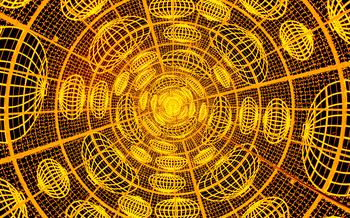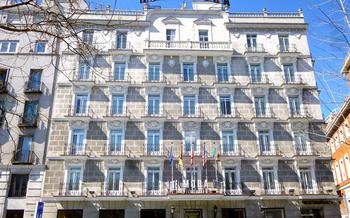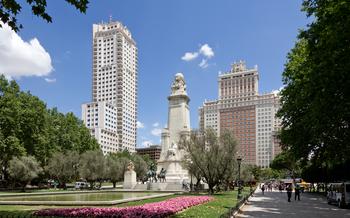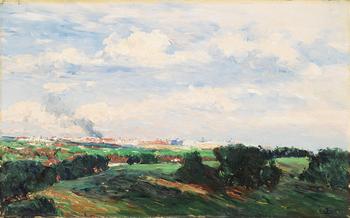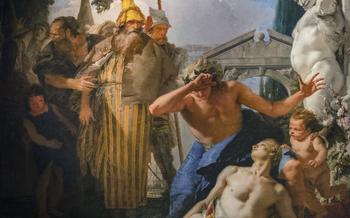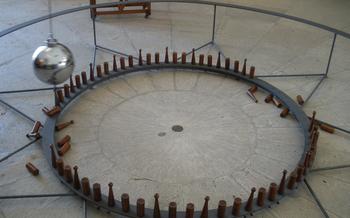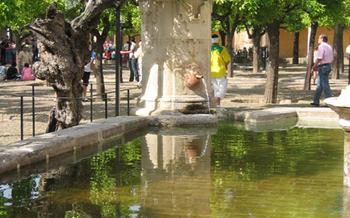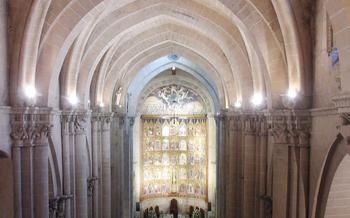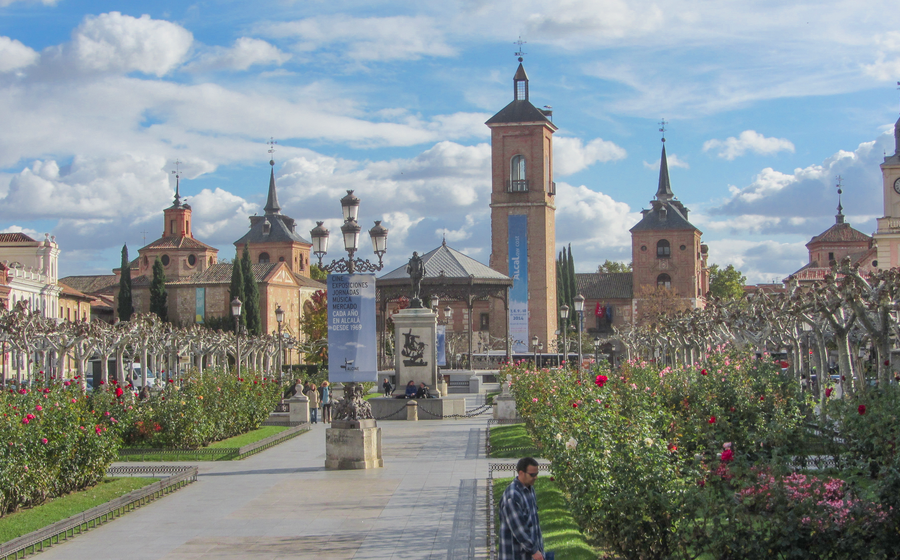
Alcalá de Henares
- Historical Background
- Visiting the Complutense University of Madrid
- Exploring the Plaza de Cervantes
- Location and Significance
- Statue of Miguel de Cervantes
- Surrounding Architecture
- Vibrant Atmosphere
- Strolling along the Calle Mayor
- Visiting the Museo Arqueológico Regional
- Enjoying the Cervantes Festival
- Taking a Day Trip to El Retiro Park
- Visiting the Royal Palace of Madrid
- Strolling along the Gran Vía
Historical Background
Alcalá de Henares, a charming city located just 35 kilometers northeast of Madrid, boasts a rich history that dates back to the Roman Empire. Its strategic location on the Henares River made it a significant settlement during the Roman period, and it later became a vital center during the Reconquista, the Christian struggle to reclaim the Iberian Peninsula from Muslim rule. In the 15th century, Alcalá de Henares reached its zenith when Cardinal Cisneros founded the Complutense University, Spain's oldest university, attracting scholars and students from across Europe. This era of intellectual and cultural flourishing laid the foundation for Alcalá de Henares' enduring legacy as a city of learning and innovation.
Visiting the Complutense University of Madrid
The Complutense is a renowned institution of higher learning located in Alcalá de Henares, just a short distance from Madrid. Founded in 1499 by Cardinal Cisneros, it is one of the oldest and most prestigious universities in Spain and the world.
History of the University: The Complutense University has a rich and storied history. It was established with the aim of promoting knowledge and scholarship in various fields, including theology, philosophy, arts, and sciences. Over the centuries, the university has undergone several transformations and has played a significant role in the intellectual and cultural development of Spain.
Notable Alumni: The Complutense University boasts an impressive list of notable alumni who have made significant contributions in their respective fields. Among them are renowned scholars, scientists, philosophers, and literary figures, including Antonio de Nebrija, Francisco de Vitoria, Miguel de Cervantes, and Federico García Lorca.
Campus Highlights: The university campus in Alcalá de Henares is a testament to its historical and architectural significance. Visitors can explore the beautiful courtyards, cloisters, and lecture halls, which have been meticulously preserved and restored. The university library, known as the Biblioteca Histórica, houses a vast collection of rare books and manuscripts.
Guided Tours: The Complutense University offers guided tours to visitors who wish to delve deeper into its history and explore its iconic landmarks. These tours provide insights into the university's academic traditions, notable figures, and architectural highlights. Visitors can learn about the university's role in shaping the intellectual and cultural landscape of Spain and its contributions to various fields of knowledge.
Exploring the Plaza de Cervantes
The Plaza de Cervantes, located in the heart of Alcalá de Henares, is a vibrant square that pays tribute to the city's most famous son, Miguel de Cervantes, author of the renowned novel "Don Quixote." The square serves as a focal point for both locals and visitors, offering a glimpse into the city's rich history and cultural heritage.
Location and Significance
The Plaza de Cervantes is situated in the historic center of Alcalá de Henares, a city with a rich academic tradition. Surrounded by stunning architecture, the square is a popular meeting spot for students, tourists, and locals alike. It derives its name from the towering statue of Miguel de Cervantes, which stands proudly in the center, overlooking the bustling square.
Statue of Miguel de Cervantes
The bronze statue of Miguel de Cervantes, created by the sculptor Arturo Mélida, immortalizes the author in a thoughtful pose, holding a book in his hand. The statue serves as a constant reminder of Cervantes' profound influence on Spanish literature and the enduring legacy of his masterpiece, "Don Quixote."
Surrounding Architecture
The Plaza de Cervantes is surrounded by a harmonious blend of architectural styles, reflecting the city's diverse history. The imposing facade of the City Hall, with its intricate stone carvings and arched windows, stands as a testament to the city's administrative and cultural significance. The surrounding buildings showcase a mix of Renaissance, Baroque, and Neoclassical influences, creating a visually captivating panorama.
Vibrant Atmosphere
The Plaza de Cervantes exudes a vibrant atmosphere throughout the day. In the mornings, students and locals gather in the square, enjoying a leisurely breakfast or coffee while basking in the warm Spanish sun. As the day progresses, the square transforms into a lively hub of activity, with street performers entertaining the crowds and vendors selling traditional Spanish souvenirs. In the evenings, the square comes alive with the sounds of music and laughter as locals and tourists alike stroll through the square, enjoying the lively ambiance.
Strolling along the Calle Mayor
The Calle Mayor is the main street of Alcalá de Henares, and it runs from the Plaza de Cervantes to the Plaza del Palacio. It is a vibrant and lively area, with a mix of historic buildings, shops, restaurants, and bars.
The Calle Mayor is home to several notable landmarks, including the Casa de la Entrevista, where Christopher Columbus met with Queen Isabella and King Ferdinand before his voyage to the New World. The street is also home to the Teatro Cervantes, a beautiful theater that hosts a variety of performances throughout the year.
The Calle Mayor is a great place to people-watch and soak up the atmosphere of Alcalá de Henares. It is also a great place to shop for souvenirs, or to stop for a bite to eat or a drink.
If you are looking for a lively and vibrant area to explore, the Calle Mayor is a must-see.
Visiting the Museo Arqueológico Regional
The Museo Arqueológico Regional is a must-visit for history buffs and archaeology enthusiasts. This museum houses an extensive collection of archaeological artifacts that provide a glimpse into the rich history of the region. From prehistoric tools to Roman mosaics, the exhibits showcase various periods of human habitation and cultural development in Alcalá de Henares and its surroundings.
Interactive displays and multimedia presentations enhance the visitor experience, making the museum a great place for families with children. Visitors can learn about the region's ancient civilizations, their customs, and their contributions to the development of the area.
Guided tours are available for those who want a deeper understanding of the exhibits. These tours provide insights into the significance of the artifacts and their historical context. The museum offers a unique opportunity to delve into the past and discover the fascinating stories of the people who shaped the region's history.
Enjoying the Cervantes Festival
Every October, Alcalá de Henares comes alive with the spirit of Miguel de Cervantes during the Cervantes Festival. This vibrant annual event celebrates the life and works of Spain's most renowned writer, who was born in Alcalá in 154
The festival, which attracts visitors from around the world, features a diverse program of events that pay homage to Cervantes and his enduring legacy. Theater performances, art exhibitions, and literary events bring the city's streets and squares to life, creating a magical atmosphere that transports visitors back to the Golden Age of Spanish literature.
One of the highlights of the festival is the Cervantes Prize, which is awarded to a distinguished author whose work embodies the spirit of Cervantes' writing. Past recipients include Mario Vargas Llosa, Carlos Fuentes, and Jorge Luis Borges.
The Cervantes Festival is a must-attend event for anyone interested in Spanish literature and culture. It's a unique opportunity to celebrate the life and work of one of the world's greatest writers in the city where he was born.
Taking a Day Trip to El Retiro Park
El Retiro Park, located in the heart of Madrid, is a sprawling green oasis that offers a respite from the hustle and bustle of city life. With its meticulously manicured gardens, tranquil ponds, and iconic landmarks, El Retiro is a must-visit destination for anyone exploring Madrid.
Covering an area of over 350 acres, El Retiro Park is a haven for nature lovers. Its lush gardens feature a diverse array of plants and flowers, creating a vibrant and colorful display. Visitors can stroll along the tree-lined paths, admiring the blooming roses, fragrant jasmine, and towering cedars. The park also boasts a beautiful rose garden, where visitors can marvel at the vibrant hues and delicate fragrances of hundreds of rose varieties.
One of the highlights of El Retiro Park is the Crystal Palace, a stunning glass and metal structure built in the late 19th century. Originally designed as a greenhouse, the Crystal Palace now serves as an exhibition space for art and cultural events. Visitors can admire the intricate glasswork and iron framework of the building, while enjoying temporary exhibitions showcasing works by local and international artists.
For those seeking a tranquil escape, the park's boating lake offers a serene and picturesque setting. Visitors can rent a rowboat or pedal boat and glide across the tranquil waters, surrounded by lush greenery and the sounds of nature. The lake is also home to a variety of waterfowl, including ducks, geese, and swans, adding to the charm and tranquility of the park.
In addition to its natural beauty, El Retiro Park is also home to several cultural and historical attractions. The park features a number of sculptures and fountains, including the iconic Statue of the Fallen Angel, which is said to be the only public monument in the world dedicated to the devil. Visitors can also explore the Velázquez Palace, a former royal palace that now houses a museum dedicated to the works of the renowned Spanish painter Diego Velázquez.
Insider Tip: For a truly unique experience, visit El Retiro Park during the Feria del Libro, an annual book fair held in the park each spring. The fair features hundreds of booksellers and publishers from around the world, showcasing a wide range of books, magazines, and other publications. Visitors can browse the stalls, meet authors, and enjoy a variety of cultural events and activities.
Visiting the Royal Palace of Madrid
A Glimpse into Spanish Royalty
Step into the grandeur of the Royal Palace of Madrid, the official residence of the Spanish royal family. This magnificent palace is a testament to the opulence and power of the Spanish monarchy. Marvel at its stunning architecture, wander through its lavishly decorated halls, and immerse yourself in the rich history and culture of Spain.
Historical Significance
Constructed in the 18th century, the Royal Palace of Madrid stands as a symbol of Spanish heritage. It has witnessed countless historical events, from royal coronations and weddings to political gatherings and state visits. Explore the palace's grand chambers, each adorned with exquisite tapestries, paintings, and furniture, and learn about the fascinating stories that have unfolded within these walls.
Architectural Masterpiece
The Royal Palace of Madrid is a masterpiece of Baroque architecture. Its imposing façade, adorned with intricate carvings and statues, sets the stage for the grandeur that awaits inside. Admire the palace's sprawling courtyards, elegant balconies, and meticulously manicured gardens. The palace's rooftop terrace offers breathtaking panoramic views of the city, making it the perfect spot to soak in the beauty of Madrid.
Guided Tours
To fully appreciate the splendor of the Royal Palace of Madrid, join a guided tour. Knowledgeable guides will lead you through the palace's opulent chambers, sharing insights into the history, art, and traditions of the Spanish monarchy. Learn about the royal family's daily life, the palace's role in Spanish history, and the priceless treasures it holds.
Unforgettable Experience
A visit to the Royal Palace of Madrid is a must for anyone interested in history, architecture, or royalty. Immerse yourself in the grandeur of this iconic landmark and gain a deeper understanding of Spanish culture and heritage. Whether you're a history buff, an art enthusiast, or simply looking for a unique and unforgettable experience, the Royal Palace of Madrid is sure to leave a lasting impression.
Strolling along the Gran Vía
Madrid's Most Vibrant Street
The Gran Vía, Madrid's most famous street, is a must-visit for any traveler. This iconic boulevard is known for its vibrant atmosphere, elegant architecture, and endless shopping and dining options.
Strolling along the Gran Vía is a feast for the senses. Marvel at the stunning architecture of the buildings, many of which date back to the early 20th century. Admire the intricate details of the facades, the colorful balconies, and the beautiful street lamps.
The Gran Vía is also a shopper's paradise. Here, you can find everything from high-end fashion boutiques to souvenir shops. Be sure to stop by the iconic El Corte Inglés department store, which offers a wide range of products, from clothing and accessories to electronics and home goods.
When it comes to dining, the Gran Vía has something for everyone. From traditional Spanish restaurants to international cuisine, there are plenty of options to choose from. Be sure to try some of the local specialties, such as cocido madrileño (a hearty stew) or churros con chocolate (fried dough pastries served with hot chocolate).
In the evening, the Gran Vía comes alive with activity. The theaters along the street host a variety of performances, from musicals to plays. There are also several cinemas, where you can catch the latest movies.
Whether you're looking to shop, dine, or simply soak up the atmosphere, the Gran Vía is a must-visit for any traveler to Madrid.
